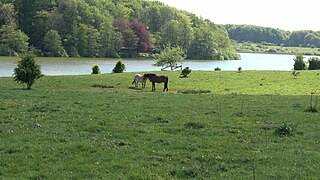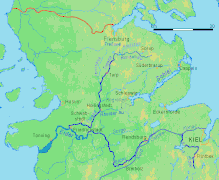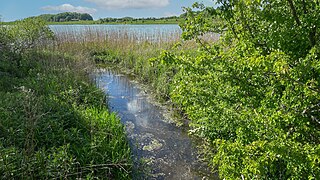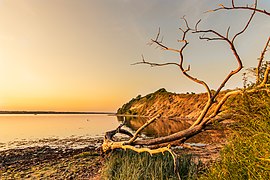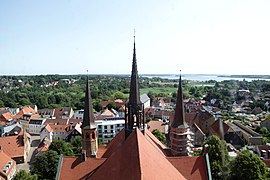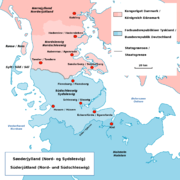Angeln
This article includes a list of general references, but it lacks sufficient corresponding inline citations. (March 2013) |
Angeln
Angeln, Angel | |
|---|---|
Geographical region Peninsula | |
From top, left to right: Glücksburg Castle, St. George's church Flensburg-Jürgensby, wind mill in Nieby, nature reserve Geltinger Birk | |
 | |
| Country | |
| State | |
| District | |
| Part of | |
| Part of | Jutland |
| District seat | Schleswig |
| Largest towns (German/Danish) | 1. Flensburg Flensborg 2. Schleswig Slesvig 3. Kappeln Kappel 4. Glücksburg Lyksborg 5. Mittelangeln Midtangel |
| Area | |
| • Total | 1,050 km2 (410 sq mi) |
| Population | |
| • Total | 201,000 |
| • Density | 190/km2 (500/sq mi) |
| Demonym | Anglian |
| Time zone | UTC+1 (CET) |
| • Summer (DST) | UTC+2 (CEST) |
| Autobahn and Bundesstraßen | |
| Closest International Airport | |
Angeln (German and Low German: Angeln; Danish and South Jutlandic: Angel; Template:Lang-ang), also known as Anglia, is a small peninsula in northern Germany, on the Baltic coast of Jutland. Jutland consists of the mainland of Denmark and the northernmost German state of Schleswig-Holstein. Anglia belongs to the region of Southern Schleswig, which constitutes the northern part of Schleswig-Holstein. The region is often referred to in German as Landschaft Angeln (Landscape Anglia) or Halbinsel Angeln (Anglia Peninsula).
To the south, Anglia is separated from the neighbouring peninsula of Swania (Ger. Schwansen, Dan. Svans or Svansø) by the Sly Firth (Ger. Schlei, Dan. Sli), and to the north from the Danish peninsula of Sundeved (Ger. Sundewitt) and the Danish island of Als (Ger. Alsen) by the Flensburg Firth (Ger. Flensburger Förde, Dan. Flensborg Fjord). The landscape is hilly, dotted with numerous lakes. Whether ancient Anglia conformed to the borders of the Anglian Peninsula is uncertain. It may have been somewhat larger; however, the ancient sources mainly concur that it also included the peninsula's territory.
Anglia has a significance far beyond its current small area and country terrain, in that it is believed to have been the original home of the Angles, Germanic settlers in East Anglia, Central and Northern England, and the Eastern Scottish Lowlands. Their migration led to their new homeland being named after them, from which the name "England" derives. England, East, Mid and West Anglia as well as the English language, thus, ultimately derive at least their names from Anglia.
Anglia is the location of two historically important castles. Glücksburg Castle in Glücksburg is the seat of the House of Schleswig-Holstein-Sonderburg-Glücksburg, which is the royal house of Norway (since 1905), and the official royal house of Denmark (since 1863; patrilineal 1863–2024). It was also the royal house of Greece (1863-1924 and 1935–1973) as well as of Iceland (1918-1944), and the king of the United Kingdom is a patrilineal member of the house. Gottorf Castle in the city of Schleswig is the ancestral seat of the House of Holstein-Gottorp, from which four Swedish kings emerged (1751-1818), as well as of the House of Holstein-Gottorp-Romanov, to which the last eight Russian emperors (1762-1917) belonged.
Terminology
The German word Angeln has been hypothesised to originate from the Germanic Proto-Indo-European root *h₂enǵʰ-, meaning "narrow", meaning here "the Narrow [Water]", i.e. the Sly Firth; the root would be *angh-, "tight" (compare Ger. and Dutch eng = "narrow", "England" = Ger. England, "narrow land" = Ger. enges Land).
The "-n"-ending is the most common ending for geographical regions in German, comparable to the English endings "-ia" and "-y": "Croatia" = Kroatien, "Italy" = Italien.
In German, the word Angeln has three other meanings: as a verb, angeln means "to angle". It is written with a capitalized initial letter in its nominalized form: das Angeln (n) = "(the) angling" (compare "(the) fishing" = das Fischen (n) or die Fischerei (f)).
When used with the plural article, Angeln means "fishing rods": die Angel (long form: die Angelrute) (f) = "the fishing rod", die Angeln (die Angelruten) (p) = "the fishing rods".
Finally, the term Angeln also refers to the people of the Angles: die Angeln (p) = "the Angles", while Eng. "the angel" = Ger. der Engel (m), "the angle" = der Winkel (m), "the angler" = der Angler (m), and "the fisherman" = der Fischer (m).
There is also a theory that Angeln meant "hook" (as in angling for fish), in reference to the shape of the peninsula. Compare Old Norse ǫngull and Modern Nynorsk angel or ongel, with the meaning (fish) hook, cognate with English angle.
Linguist Julius Pokorny derived it from the Proto-Indo-European root *ang-, "bend" (see ankle).[1]
It is also possible that the Angles may have been called such because they were a fishing people or were originally descended from such.[2]
Geography

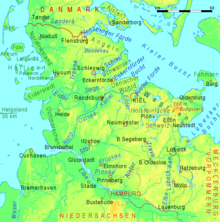
Together with Swania (Ger. Schwansen, Dan. Svans or Svansø), Danish Wahld (Ger. Dänischer Wohld, Dan. Jernved) and Wagria (Ger. Wagrien, Dan. Vagrien), Anglia is one of four peninsulas along the Baltic coast of the northernmost German federal state of Schleswig-Holstein. As part of the Schleswig-Holstein Morainic Uplands (Ger. Schleswig-Holsteinisches Moränenhügelland), that were formed during the Weichselian glaciation, these peninsulas are hilly and dotted with several glacial lakes.
The Anglian lakes are subdivided into the North Anglian Lake Group (Ger. Nordangeliter Seengruppe) and the South Anglian Lake Group (Südangeliter Seengruppe). The River Treene (Dan. Trenen) with its main headstreams Bondenau (Dan. Bondeåen) and Kielstau (Kilså) rises in Anglia. Although rising on the Anglian Peninsula in the Baltic Sea, the Treene flows towards the North Sea, being the main tributary of the River Eider (Dan. Ejderen), the river that constituted the southern border of the Danish Realm as well as the language boundary between Danish and Low German for a very long time.
The northernmost part of Anglia is formed by the Holnis (Dan. Holnæs) Peninsula (de), that protrudes into the Flensburg Firth and separates the inner firth (Innenförde) from the outer firth (Außenförde). The transition zone from the Anglian Uplands to the Schleswig Geest is called Luusangeln (de) (Lusangel), whose appearance resembles a landscape park. The designation comes from the Anglian Danish word for "bright", lus (Standard Danish lys), and indicates the comparatively predominantly light colour of the widespread sand-rich podzols there. The Schleswig Geest in turn merges into the Schleswig tidal marshes of North Frisia.
Apart from Flensburg, which is an independent town, the Anglian Peninsula belongs to the district of Schleswig-Flensburg (Dan. Slesvig-Flensborg), Germany's northeasternmost district (seat: Schleswig (Slesvig)). This comparatively rural district has approximately 200 025 inhabitants (as of 31 December 2018).
-
Südensee (German) or Søndersø (Danish), a glacial lake in Anglia
-
Valley of the Munkbrarupau (Brarup Å) near Munkbrarup
-
Beach of Nieby
-
Avenue in Schaalby
Lakes
The largest North Anglian lakes:
- Sankelmarker See (de) - Sankelmark Sø (da)
- Südensee (da) - Søndersø (da)
- Winderatter See (de) - Venerød Sø (da)
- Treßsee (de) - Træsø (da)
- Havetofter See (de) - Havetoft Sø (da)
- Rüder See - Ryde Sø
The largest South Anglian lakes:
- Langsee (de) - Langsøen (da)
- Arenholzer See (de) - Arnholt Sø (da)
- Idstedter See - Isted Sø (da)
- Reethsee (de) - Rørsø (da)
- Bocksee - Buksø (da)
-
Winderatter See
-
Sankelmarker See
-
Winderatter See
-
Angling place at Südensee
Rivers
The chain of hills running across Anglia between Husby and Kappeln constitutes the drainage divide between Baltic and North Sea. East of it, small streams mostly called Au flow towards the Baltic. West of it, most streams flow towards the Treene and later the Eider and hence into the North Sea.
The Treene is the longest tributary of the Eider, and its two headstreams Bondenau and Kielstau rise in and flow through Anglia. The sources of the Bondenau are in Mohrkirch and in Sörup-Sörupholz. At Mittelangeln-Bondebrück, the Südensee Au (de) joins the Bondenau. The Kielstau rises in Sörup-Schwensby, passes through Winderatter See, and flows into the Bondenau at Großsolt, just before the Bondenau enters Treßsee (de). Upon leaving the lake, the river takes on the name Treene, and leaves Anglia to the west. It enters the Eider at Friedrichstadt, which in turn enters its extensive estuary called Purrenstrom (de) at Tönning, at the end of which is located the Eider Barrage Eidersperrwerk.
The largest river system that flows entirely in Anglia from its sources to its mouth, is the system of the Füsinger Au. This river is called Loiter Au in its upper course, and is formed by the confluence of the Boholzer Au (which is called Wellspanger Au (de) in its upper course), and the Oxbek (de) (which is also called Mühlenau, and whose longest tributary is the Flaruper Au). The Füsinger Au flows into the Schlei at Winningmay (municipality of Schaalby), east of Schleswig.
-
Map of the longest rivers in northern Schleswig-Holstein
-
The Kielstau enters Winderatter See
-
The Treene valley just west of Treßsee
-
The Lippingau flowing towards the Baltic
Nature reserves


There are 10 officially designated nature reserves (Naturschutzgebiete) in Anglia:
- Geltinger Birk (Gelting Birk) (de)
- Halbinsel Holnis (Holnis Peninsula) (de)
- Hechtmoor (Hechtmoor Bog) (de)
- Höftland Bockholmwik und angrenzende Steilküsten (Höftland Bockholmwick and adjacent steep coasts) (de)
- Obere Treenelandschaft (Upper Treene Landscape) (de)
- Os bei Süderbrarup (Esker near Süderbrarup) (de)
- Pugumer See und Umgebung (Pugumer See and surroundings) (de)
- Reesholm/Schlei (de)
- Tal der Langballigau (Valley of the Langballigau) (de)
- Schleimündung (Mouth of the Schlei) (de)
Apart from that, there is one nature park: Naturpark Schlei (Nature Park Schlei) (de). The nature reserve Haithabu-Dannewerk (de) lies just southwest of Anglia. It stretches along the Danevirke and around the former Danish Viking Age settlement of Hedeby, which were both declared the world heritage site "Archaeological Border complex of Hedeby and the Danevirke" (de) by UNESCO.
-
Coast of the Gelting Birk
-
Landscape of the Gelting Birk
-
Coast of the Holnis Peninsula
-
Lighthouse Schleimünde in the nature reserve "Mouth of the Schlei"
Cities

There are five cities in Anglia. All other settlements are just municipalities, all belonging to an Amt, which is a collection of municipalities administratively classified as between the local and the county government. The only exception is the city of Arnis, which belongs to the Amt of Kappeln-Land.
Flensburg: The largest city touching Anglian territory is Flensburg (pop. 92,550). The city is called Flensborg in Low German and Danish, Flensborre in South Jutlandic, and Flansborj or Flensborag in North Frisian. Not the whole city belongs to Anglia, but only about half of the city, namely the eastern boroughs of Engelsby, Fruerlund, Jürgensby, Mürwik, Sandberg and Tarup, excluding the city centre. The Anglian districts alone have a population of around 46,000 inhabitants, which is enough to make Flensburg the by far most populous city in the region.
Schleswig: The second-largest city is Schleswig (pop. 25,832), which belongs almost entirely to Anglia, including the city centre. It is called Sleswig in Low German, Slesvig in Danish, and used to be called Slasvjig in Anglian Danish. There are just two boroughs that do not belong to Anglia because they are located on the adjacent Swania Peninsula: St. Jürgen and Klosterhof. To compensate for the loss of political and administrative functions as former capital of the Duchy of Schleswig and later the Province of Schleswig-Holstein, Schleswig became the seat of the Schleswig-Holsatian Higher Regional Court, the State Archives, the State Museum of Art and Cultural History and the Archaeological State Museum (the latter two being located in Gottorf Castle) between 1947 and 1948. Schleswig is therefore a cultural and the justicial centre for the state of Schleswig-Holstein.
Kappeln (Danish: Kappel) (pop. 8,607) is the third-largest city on Anglian territory. Although most of the city's area has been on the Swania Peninsula since the incorporation of Olpenitz in 1970, most of the districts and the city centre belong to Anglia. The Anglian boroughs are: Dothmark, Ellenberg, Kappeln (core city), Mehlby, Sandbek and Stutebüll. The boroughs in Swania are: Kopperby and Olpenitz. In Kappeln, the region's largest urban development project is being carried out, in the course of which the former Olpenitz naval base is being converted into the "Olpenitz Baltic Sea Resort" (de:Ostseeresort Olpenitz).
Glücksburg (Ostsee): The fourth-largest city of Glücksburg (Ostsee) (pop. 6,377) is the largest city lying entirely in Anglia. It is called Glücksborg in Low German and Lyksborg in Danish. It is the northernmost city in Germany, as List on Sylt, that is known as northernmost settlement of the country, is just a village and municipality. The core area of the city consists of the boroughs of Bremsberg (Bremsbjerg), Sandwig (Sandvig) with Quellental (Kildedal), and Ulstrupfeld (Ulstrupmark). The entire area of the Holnis Peninsula was incorporated into Glücksburg.
Arnis: With less than 300 inhabitants, Arnis (Danish: Arnæs) (pop. 273) is the least populous city in Germany and, at 0.45 square kilometres (0.17 sq mi), also the smallest city in terms of area. The city extends on a densely built-up small peninsula in the middle of the Schlei.
-
Flensburg is the largest town in Anglia. View of the borough of Jürgensby (Jørgensby) on the Anglian side of the Flensburg Firth.
-
Another view of Jürgensby and the harbour of Flensburg.
-
View from Schleswig Cathedral
-
View of the Schlei Bridge in Kappeln
Traffic
Railway
The Neumünster–Flensburg railway runs along the western edge of Anglia, and connects the two largest Anglian cities of Flensburg and Schleswig via the stations of Tarp and Jübek. In the south, it merges into the route to Hamburg, and in the north into the route to Fredericia.
Anglia is crossed by the Kiel–Flensburg railway, that runs from the Schleswig-Holsatian capital of Kiel to Flensburg and connects the Baltic Sea ports of Kiel, Eckernförde and Flensburg. After leaving Kiel, it crosses the Kiel Canal on the Levensau High Bridge, and then runs via Eckernförde and across the Swania Peninsula in the diretion of the Schlei. It crosses the Schlei on the Lindaunis Bridge between the stations Rieseby Schleibrücke Süd in Swania, and Boren-Lindaunis Schleibrücke Nord, which is the first station in Anglia. It then runs across Anglia in the direction of Flensburg via the stations Lindaunis, Süderbrarup, Sörup and Husby. An additional station at Flensburg-Tarup will be built. A new Lindaunis Bridge, which is being constructed since October 2019, shall be completed in 2025.
At the station Süderbrarup, the "Angelner Dampfeisenbahn" (Anglian Steam Railway) (de) is connected to the Kiel–Flensburg railway. It runs from Süderbrarup to Kappeln, and there are through trains from Kappeln to Eckernförde.
-
Flensburg station
-
The Anglian Steam Railway at Kappeln
Motorway

The Bundesautobahn 7 (Federal Motorway 7, from Grenzübergang/Grænseovergang Ellund (D)/Frøslev (DK) to Grenzübergang Füssen (D)/Vils (AT)) runs along the western edge of Anglia, and connects Flensburg to Schleswig. Exits along the Anglian Peninsula are "Flensburg/Harrislee", "Flensburg", "Tarp" and "Schleswig/Schuby". It merges into the Danish Sønderjyske Motorvej (E45) in the direction of Kolding in the north.
Languages


The language most spoken in Anglia is German. The peninsula is, however, also part of the language area of Low German (Low Saxon), which is more closely related to English than German is, since it was not affected by the High German consonant shift.
Before the 9th century, Anglia was inhabited by the Angles, who spoke West Germanic dialects. A language shift to North Germanic occurred, when the peninsula was occupied by the Danes after the Angles had long left for Britain, and Danish became the main language of the region between the 9th and 19th centuries. In the 19th century, another language shift happened, and the predominant language changed from the North Germanic Danish to the West Germanic Low German. Since the late 20th century, Low German is more and more superseded by a variant of German with Low German traits.
The Danish variety indigenous to Anglia was Anglian Danish (Dan. Angeldansk or Angelbomål, Ger. Angeldänisch), a dialect of South Jutlandic (Synnejysk, Dan. Sønderjysk, Ger. Südjütisch or Südjütländisch), the southernmost variety of Danish spoken on the Jutland Peninsula, which was once spoken as far south as Eckernförde-Borby (Dan. Egernførde or Egernfjord-Borreby) on the Eckernförde Bay (Ger. Eckernförder Bucht, Dan. Egernførde Fjord).
Danish remains being spoken in Anglia by a minority, but the dialects spoken nowadays are Southern Schleswig Danish dialects, which are not dialects of the previously indigenous South Jutlandic, but (Low) German-influenced dialects of Standard Danish. The cities with the largest Danish-speaking minorities are Flensburg (Flensborg), Schleswig (Slesvig) and Glücksburg (Lyksborg).
Many Anglian placenames are of Danish origin, including placenames ending in -by ("city"), such as Brodersby-Goltoft, Flensburg-Engelsby (Flensborg-Engelsby), Flensburg-Jürgensby (Flensborg-Jørgensby) or Nieby (Nyby); and placenames ending in -rup ("village"), such as Sörup (Sørup), Sterup or Tastrup (Tostrup). There are many placenames of Danish origin in England as well, such as Derby, Rugby or Whitby, but in Danish, German and Swedish -by is pronounced [byː], not [biː] as in England.
North Frisian, one of the Frisian languages that form the group of Anglo-Frisian languages together with English, is spoken in many dialectal variants in neighbouring North Frisia along the North Sea coast of Schleswig-Holstein and on the North Frisian Islands.
History
Early history

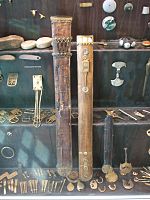
The region was home to the Germanic people of the Angles, some of whom, together with Saxons and Jutes, left their homeland to migrate to the island of Great Britain in the 5th and 6th centuries.
The Thorsberg Moor as most important Anglian archaeological site
The Thorsberg moor (Danish: Torsbjerg Mose) is a peat bog in the municipality of Süderbrarup. This inconspicuous body of water is an important archaeological site and a Germanic sacrificial bog from the times of the Roman Empire. In the period from the 1st century BC to the early 5th century AD, objects were sacrificed in several phases in the Thorsberg Moor, presumably by members of the West Germanic tribe of the Angles. Numerous important and rich cultural and historical finds were made in the bog in the 19th century. The current name does not allow the assumption that the sanctuary was already consecrated to the god Thor at the time of the Angles. Rather, the naming is based on early medieval Danish influence, especially in the Viking Age. With the migration of most Angles to Britain came widespread discontinuity in settlement and cultural structure in Anglia. While it is possible that the early medieval Danish settlers did worshiped Thor, the name is more likely to be traced back to a hill with a Viking Age burial ground and finds, the Thorsberg.
Emigration of the Angles to Britain
The settlement density in Anglia apparently decreased dramatically in the 5th and 6th centuries; many villages fell into disrepair. A sharp decline in grain pollen suggests a desertion of former fields. Locations with heavy, clayey soils were abandoned first. Since more pollen was found at some locations of the Schleswig Geest (the region adjacent to Anglia to the west), it is assumed that the climate had changed. Increased rainfall could explain this move to the sandy geest areas. Another reason for leaving settlements near the coast is believed to be attacks from the sea. This initially regional migration would also explain another phenomenon: it is now considered likely that between the end of the settlement period of the Angles in Anglia and their arrival in eastern and central England up to 100 Years passed. The Angles would have initially moved west, to the Schleswig Geest, before leaving their home completely.
For the years 449–455, the Anglo-Saxon Chronicle, written around 890, describes how King Vortigern, a British king, invited the Angles to come and receive land in return for helping him defend his realm against marauding Picts. Those successful Angles sent word back that good land was available and that the British were "worthless". A wholesale emigration of Angles and kindred Germanic peoples followed.
The Chronicle, commissioned by King Alfred the Great, drew on earlier oral traditions and on the few written fragments available. The best of these, written around 730, was by the monk Bede, whose history of English Christianity contains the following brief account of the origin and distribution of the Angles:[3]
from the Angles, that is, the country which is called Anglia, and which is said, from that time, to remain desert to this day, between the provinces of the Jutes and the Saxons, are descended the East Angles, the Midland Angles, Mercians, all the race of the Northumbrians, that is, of those nations that dwell on the north side of the River Humber, and the other nations of the English.
— Bede's Ecclesiastical History of the English People, Book I, Chapter XV, 731 A.D.
The phrase "north of the Humber" refers to the northern kingdom of Northumbria, which included most of northern England and part of southern Scotland. Mercia was located in central England and broadly corresponds to the English Midlands.
This account can be related to the evidence of archaeology, notably the distribution of types of fibulae, or brooches, worn by both men and women in antiquity. Eastern and northern Britain were settled by groups wearing cruciform brooches, of the style in fashion at the time in coastal Scandinavia, Denmark, and Schleswig-Holstein south to the lower Elbe and east to the Oder, as well as a pocket in coastal Friesland.
Later history
After the Angles departed from Anglia, by the 8th century the region was occupied by Danes. This is reflected in the large number of place names ending in -by (meaning "city") in the region today. In the 10th century, the chronicler Æthelweard reports that the most important town in Anglia was Hedeby (Ger. Haithabu).
Later Anglia's history is subsumed in that of the larger surrounding region, which came to be known as Southern Jutland or Schleswig (Dan. Slesvig). Until the 19th century the area belonged to Denmark. In terms of ethnic and linguistic heritage the countryside spoke a Danish dialect until the early 1800s after which Low German spread northwards, whereas the towns spoke Low German from the late medieval era. Denmark lost Schleswig to Austria and Prussia in 1864 as a result of the Second Schleswig War. In 1920, following Germany's defeat in the First World War, a plebiscite was held to determine which areas should return to Danish control. As a result of the plebiscite, the northern part of Schleswig returned to Denmark, but Anglia remained in Germany. See Schleswig-Holstein Question for a detailed history.
-
Schleswig and Holstein around 1650
-
map of the Duchy of Schleswig in 1650
-
Subdivision of Schleswig since 1920
Coat of arms and flags
The coat of arms of Anglia is not a sovereign symbol, but is very popular among the residents of the peninsula. It is particularly widespread on flags with the state colors of Schleswig-Holstein and on decorative plates. It was designed by Hans Nicolai Andreas Jensen and appeared for the first time in 1847 during the festival for the members of the XI. Meeting of German farmers and foresters. The design of the overcrowded coat of arms does not follow heraldic rules. It consists of nine fields, all but one of which represent the historic Danish hundreds (Danish: herreder, German: Harden) of Anglia:
- Husby Herred (da) - Husbyharde (de): stylized house
- Munkbrarup Herred (da) - Munkbrarupharde (de): Saint Lawrence griddle
- Ny Herred (da) - Nieharde (de): star and crescent
- Slis Herred (da) - Schliesharde (de): herring and waves
- The east Anglian goods district was not subject to herreder jurisdiction, but was directly subordinate to the sovereign. It was only converted into Kappel Herred (da) - Kappelner Harde (de) in 1853, and is therefore symbolized by two Schleswig lions.
- Strukstrup Herred (da) - Struxdorfharde (de): stylized oak
- Satrup Herred (da) - Satrupharde (de): scythe
- Mårkær Herred (da) - Mohrkirchharde (de): tau cross
- Fysing Herred (da) - Füsingharde (de): crossed keys
In the original draft of the coat of arms, the Husby Herred was symbolically represented by two crossed arrows with a heart in front of them. From 1906 at the latest, the stylized house corresponding to the old herred seal appeared instead. The original version of the coat of arms can therefore still be found occasionally. The symbol for the Ugle Herred (da) - Uggelharde (de), which only partially belonged to Anglia, is missing from the coat of arms.
Two types of flags are popular among the Anglian population. One shows the colors of the flag of Schleswig-Holstein with the Anglian coat of arms at the centre (the Anglian flag). The other is the Danish flag with the Anglian coat of arms at the centre of the Nordic cross (the Angledanish flag).
-
Anglian coat of arms
-
Anglian flag
-
Angledanish flag
-
former subdivision of Anglia into herreder
-
Anglian coat of arms as it appeared 1847-1906
See also
Notes
- ^ Barber, Charles, Joan C. Beal and Philip A. Shaw 2009. The English language. A historical introduction. Second edition of Barber (1993). Cambridge: University Press.
- ^ Baugh, Albert C. and Thomas Cable 1993 A history of the English language. 4th edition. (Englewood Cliffs: Prentice Hall)
- ^ Halsall, Paul (ed.). "Medieval Sourcebook: Bede (673–735): Ecclesiastical History of the English Nation, Book I". Internet History Sourcebooks Project. Fordham University. Retrieved 2 September 2017.
References
- Ecclesiastical History of the English Nation, Book I, Bede, c. 731
- The Anglo-Saxon Chronicle: Translated and collated by Anne Savage, Dorset Press, 1983, ISBN 0-88029-061-7
- Malcolm Falkus and John Gillingham, Historical Atlas of Britain, Crescent Books, 1987, ISBN 0-517-63382-5












